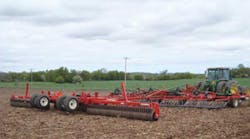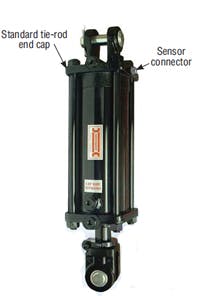As commercial farms become larger, agricultural equipment must run faster and feature more automated operations to maximize productivity. More automated machines require less operator intervention because electronic sensors and controls take over many of the functions otherwise performed manually. And because hydraulics is such an integral part of commercial ag equipment, fitting hydraulic components — especially cylinders — with electronic sensors is a key to advancing the state of the art of ag equipment.
Tie rod cylinders have long been the workhorse of ag equipment. But, in general, designers had to choose between either resistive or magnetostrictive linear displacement transducers (LDTs) to provide cylinders with electronic position feedback capability. An alternative to these conventional solutions is offered by Rota Engineering Ltd., Manchester, U.K. Mark Hoffman, of Rota Engineering’s US facility, Allen, Texas, said the Rota Engineering sensor uses Hall effect technology to monitor the position of a magnet embedded within the cylinder’s piston.
The search for smarts
Midway Mfg. Inc., Kinsley, Kansas, designs and manufactures ASAE compliant hydraulic cylinders with bores from 1½ to 5 in. and strokes from 8 to 16 in. for use in ag equipment. Midway also provides cylinders for automotive, oil field, construction, logging, material handling, marine, mining, rail, utility, and stationary industrial equipment.
Dan Woolard, president of Midway Mfg., explains, “One of the trends in mobile equipment is the need for smart cylinders.” He explained that companies have tested sensors mounted outside the cylinder to circumvent the constraints of in-cylinder mounting. “But by and far they do not stand up to the rough environment,” he revealed
Woolard continued, “The choice seemed logical to go with an internal technology due to the added protection. But resistive technologies have a limited life cycle, so the trend is towards non-contact technologies. Magnetostrictive technologies are non-contact, but their large size does not allow them to be installed inside a cylinder, where space is constricted — unless you deviate from ASAE dimensions.”
Midway Mfg. found a solution with Rota Engineering’s LA series sensors. Woolard explained, “The Hall effect sensor offers non-contact, absolute sensing in a compact, shock- and vibration-resistant package that stands up to the harsh environments our cylinders are subjected to. We simply mount the head of the sensor in the base of our tie rod cylinder, slide the gun drilled piston and rod over the length of the sensor, then install the cylinder tube. A magnet in the end of the cylinder rod communicates with the microprocessor-based sensor as the cylinder rod strokes in and out. The microprocessor determines the appropriate proportional output value based on voltage, current, PWM and digital signals required.
Application from the field
“The application that drove us down this road was an ag OEM that wanted to control depth of their tillage implement,” said Woolard. “The new technology allows the farm manager to accurately determine the compaction depth of the soil in his field, and that information is transferred to the tractor. As a result, the implement only goes as deep as it needs to throughout the field.
“For example, if the soil compaction is 5 in. for part of the field and they need to go to 6 in. to break up that compaction, but in other parts of the field they need to go to 9 in. to break up 8 in. of compaction, the tractor now controls the depth of the implement so it does not have to be set for 9 in. for the entire field and waste fuel, reduce moisture content and increase wear and tear on the implement.”
For more information on Midway cylinders, call (620) 659-3631 or visit www.midwaymfg.com. Contact Rota Engineering at (972) 359-1041 or visit www.rota-eng.com.



